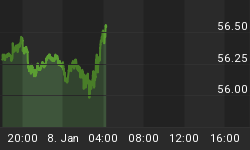MONETARY TIGHTENING - Over the past few months, there has been a lot of talk pertaining to the ongoing monetary tightening. In fact, central banks are being widely applauded in the mainstream media for raising short-term interest-rates and "fighting" inflation. Moreover, the "tight" liquidity conditions prevalent today are being held responsible for the recent sharp declines in commodities and the emerging-markets. The current sentiment seems to be leaning more towards deflation, which is a major shift away from the runaway-inflationary fears present not so long ago.
In my view, not much has really changed and we are still living in a highly inflationary environment. Although, I concede that the rate of inflation (money-supply growth) in the US has been in decline since 2002 (Figure 1); bank credit continues to grow at a record-pace - $4.4 trillion annualised in 2006 compared to $3.3 trillion last year. So, there is no scarcity of money and credit today. In the past, whenever the central banks were serious about monetary tightening, credit contracted in a meaningful way compared to the previous year. After all, monetary tightening has one prime objective: to curtail credit in order to prevent excesses in the economy and capital markets. On this account, the central banks have done a poor job of tightening as credit growth (not captured in the money-supply figures) is still in the stratosphere.
Figure 1: US inflation (monetary-growth) in decline
Source: www.yardeni.com
In summary, money-supply growth has contracted somewhat due to rising short-term interest-rates, but this has been largely offset by a surge in bank credit, thereby making the monetary tightening ineffective.
It is critical to understand that monetary inflation is now a global phenomenon and over the long-term, the purchasing power of your savings will be confiscated regardless of the "paper" currency you select. Take a look at the latest money-supply growth-rates around the world:-
Australia | + 10.4% |
Britain | + 13.7% |
Canada | + 6.5% |
Denmark | + 7.4% |
US | + 4.9% |
Euro zone | + 7.4% |
So you can see that despite the monetary "tightening" being advertised by the media, over the past year, the supply of money has continued to grow rapidly.
It is interesting to note that the rate of inflation or money-supply growth in the US peaked in 2002 (Figure 1) however, the public only started to get worried about this problem earlier this year when inflation was significantly lower than the previous 4 years. On the contrary, in 2002, when the inflation-rate was extremely high, most people were concerned about deflation! This may seem totally absurd but it begins to make sense when you realise that most people equate rising prices to inflation and falling prices to deflation. The majority fail to understand that rising prices are an effect of inflation (money-supply growth) and falling prices are an effect of deflation (money-supply contraction). So, when asset-prices collapsed in 2002 following the NASDAQ-bust, a "deflation scare" emerged, thus giving the Federal Reserve the perfect excuse to inflate. Figure 1 shows that the US inflation-rate in 2002 rose to a shocking 22%! Back then, as the supply of money (or inflation) soared, its effects (rising asset and commodity prices) only started becoming more visible to the public 4 years later. This is due to the fact that there is a time-lag between inflation (the cause) and rising prices (the effect).
Today, the rate of inflation (money-supply growth) in the US is relatively subdued, commodity prices have taken a beating, real-estate is cooling-off and a "deflation scare" is emerging yet again. If history is any guide, you can be sure that the response of the central banks will be to accelerate the supply of money and credit to unprecedented levels. I suspect that the next bout of inflation is not far away and when it occurs, the current trough in asset-prices will end, setting the stage for the next advance in asset-prices.
As investors living amidst an endless supply of paper "money", we must not underestimate the inflationary powers of the central banks. Back in March 2000 when the tech-bubble burst, I bet against the US stock-market, which after 2003 was a painful experience as asset-prices rebounded sharply due to monetary inflation. So, in the current inflationary environment, I would not advise you to try and profit from falling asset-prices. A better strategy is to utilise the current weakness in asset-prices and take positions in precious metals, commodities and the emerging stock-markets where a sound case can be made for a sustainable boom.
Since the early 1970's when gold was removed from the monetary system, we have seen constant inflation around the world. Figure 2 captures this development and confirms that the total non-gold international reserves worldwide have grown to US$4.6 trillion today; a 46-fold increase from the 1974 level of US$100 billion!
Figure 2: Non-gold reserves at a record high!
Source: www.yardeni.com
In the 1970's, this liquidity found a home in tangible assets (commodities) and in the 1980's and 1990's, it rushed into financial assets pushing stocks and bonds in the developed world to record-highs. Since the start of the millennium, capital has been flowing out of financial assets and rushing (yet again) towards tangibles. Over the coming decade or so, I expect this trend to accelerate, which will cause the prices of precious metals and commodities to rise immensely.
The above is an excerpt from Money Matters, a monthly economic publication, which highlights extraordinary investment opportunities in all major markets. In addition to the monthly reports, subscribers also benefit from timely and concise "Email Updates", which are sent out when an important development in the capital markets warrants immediate attention. Subscribe Today!
















